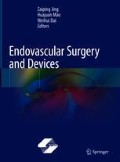Abstract
There are six major techniques for endovascular treatment, i.e., percutaneous endovascular balloon angioplasty, endovascular stent angioplasty, endovascular graft exclusion for artery dilatations, endovascular thrombolysis, endovascular embolectomy, and minimally invasive endovascular replacement of cardiac valves, none of which can do without continuous improvement and innovation of endovascular devices. While Seldinger percutaneous vascular puncture has opened the first chapter of endovascular treatment, percutaneous endovascular balloon angioplasty is the first step of endovascular treatment. It has experienced the stages of catheter dilatation, classical balloon dilation, special drug-eluting balloon, and so forth, having laid the foundation of endovascular treatment. Similarly, stent, a representative of endovascular implants, has also undergone continuous innovations of bare stent, drug-eluting stent, and absorbable stent. However, when it comes to comparing the long-term advantages and disadvantages of stents of different configurations and materials after having been applied at different sites of the human body, more clinical researches are required for further confirmation. Besides progress in peripheral arterial devices, fast-changing innovations are also being carried out on devices used for the endovascular treatment of aortic diseases. As for endovascular devices applied to aortic dilatations, from the coating materials at the beginning, through the small-caliber delivery systems, to the innovations in the overall configurations of stent grafts, more and more aortic diseases which could not handle minimally invasive endovascular treatment in the past can now be cured through endovascular treatment. In short, endovascular devices adopt further minimally invasive treatment, higher disease adaptability and better long-term effectiveness as their development directions, and the endless emergence of new design concepts (such as individualized customization), new materials and new manufacturing processes forecasts the accelerated arrival of an era in which all vascular diseases can be cured through minimally invasive endovascular treatment.
Access this chapter
Tax calculation will be finalised at checkout
Purchases are for personal use only
References
White GH, Yu W, May J, et al. Endoleak as a complication of endoluminal grafting of abdominal aortic aneurysms: classification, incidence, diagnosis and management. J Endovasc Surg. 1997;4(2):152–68.
Naghi J, Yalvac EA, Pourdjabbar A, et al. New developments in the clinical use of drug-coated balloon catheters in peripheral arterial disease. Med Devices (Auckl). 2016;9:161–74.
Chaikof EL, Blankensteijn JD, Harris PL, et al. Reporting standards for endovascular aortic aneurysm repair. J Vasc Surg. 2002;35:1048–60.
Veith FJ, Baum BA, Ohki T, et al. Nature and significance of endoleaks and endotension: summary of opinions expressed at an international conference. J Vasc Surg. 2002;35:1029–35.
Baxendale BR, Baker DM, Hutchinson A, et al. Haemodynamic and metabolic response to endovascular repair of infrarenal aortic aneurysms. Br J Anaesthesia. 1996;77:581–5.
Baum RA, Carpenter JP, Cope C, et al. Aneurysm sac pressure measurements after endovascular repair of abdominal aortic aneurysms. J Vasc Surg. 2001;33:32–41.
Mehta M, Veith FJ, Ohki T, et al. Significance of endotension, endoleak and aneurysm pulsatility after endovascular repair. J Vasc Surg. 2003;37:842–6.
Hagan PG, Nienaber CA, Isselbacher EM, et al. The international registry of acute aortic dissection (IRAD): new insight into an old disease. JAMA. 2000;283:897–903.
Zimpfer D, Schima H, Czerny M, et al. Experimental stent-graft treatment of ascending aortic dissection. Ann Thorac Surg. 2008;85:470–3.
Wang Z, Massimo C, Li M, et al. Deployment of endograft in the ascending aorta to reverse type A aortic dissection. Asian J Surg. 2003;26:117–9.
Feng R, Zhao Z, Bao J, et al. Double-chimney technology for treating secondary type I endoleak after endovascular repair for complicated thoracic aortic dissection. J Vasc Surg. 2011;54:212–5.
Yuan L, Feng X, Jing Z. Endovascular repair of a thoracic arch aneurysm with a fenestrated stent-graft. J Endovasc Ther. 2008;15:539–43.
Lu Q, Jing Z, Zhao Z, et al. Endovascular stent graft repair of aortic dissection type B extending to the aortic arch. Eur J Vasc Endovasc Surg. 2011;42:456–63.
Lin C, Lu Q, Liao M, et al. Endovascular repair of the half aortic arch in pigs with an improved, single-branched stent graft system for the brachiocephalic trunk. Vascular. 2011;19:242–9.
Hayashida K, Lefevre T, Chevalier B, et al. Transfemoral aortic valve implantation new criteria to predict vascular complications. JACC Cardiovasc Interv. 2011;4:851–8.
David HD, Manish M, Karthik K, et al. The phase I multicenter trial (STAPLE-1) of the Aptus endovascular repair system: results at 6 months and 1 year. J Vasc Surg. 2009;49:851–7; discussion 857–858.
Leon MB, Smith CR, Mack M, et al. Transcatheter aortic- valve implantation for aortic stenosis in patients who cannot undergo surgery. N Engl J Med. 2010;363:1597–607.
Reijnen MM, de Bruin JL, Mathijssen EG, et al. Global experience with the nellix endosystem for ruptured and symptomatic abdominal aortic aneurysms. J Endovasc Ther. 2016;23:21–8.
Stone GW. Bioresorbable vascular scaffolds: more different than alike? JACC Cardiovasc Interv. 2016;9:575–7.
Author information
Authors and Affiliations
Corresponding author
Editor information
Editors and Affiliations
Rights and permissions
Copyright information
© 2018 Springer Nature Singapore Pte Ltd. and Shanghai Scientific and Technical Publishers
About this chapter
Cite this chapter
Feng, J., Jing, Z. (2018). Development History of Endovascular Surgery and Devices. In: Jing, Z., Mao, H., Dai, W. (eds) Endovascular Surgery and Devices. Springer, Singapore. https://doi.org/10.1007/978-981-10-8270-2_1
Download citation
DOI: https://doi.org/10.1007/978-981-10-8270-2_1
Published:
Publisher Name: Springer, Singapore
Print ISBN: 978-981-10-8269-6
Online ISBN: 978-981-10-8270-2
eBook Packages: MedicineMedicine (R0)

